Rail Engineering Project: Strategies, Procedures, and Documentation
VerifiedAdded on 2023/06/18
|21
|4179
|259
Report
AI Summary
This report details engineering strategies associated with rail engineering equipment, including Reliability, Availability, Maintainability, and Safety (RAMS) and Failure Modes and Effects Analysis (FMEA). It discusses the advantages and disadvantages of various strategies for completing engineering activities in the rail industry, such as preventative, predictive, and corrective maintenance. The report justifies the procedures employed for rail engineering situations, focusing on verification and validation processes. Finally, it evaluates the process for recording and documenting engineering activities to ensure compliance with safety and regulatory standards, highlighting the importance of Depot Safety Management Systems (DSMS) and adherence to legal requirements.

PROJECT REATK4- 7C
Paraphrase This Document
Need a fresh take? Get an instant paraphrase of this document with our AI Paraphraser
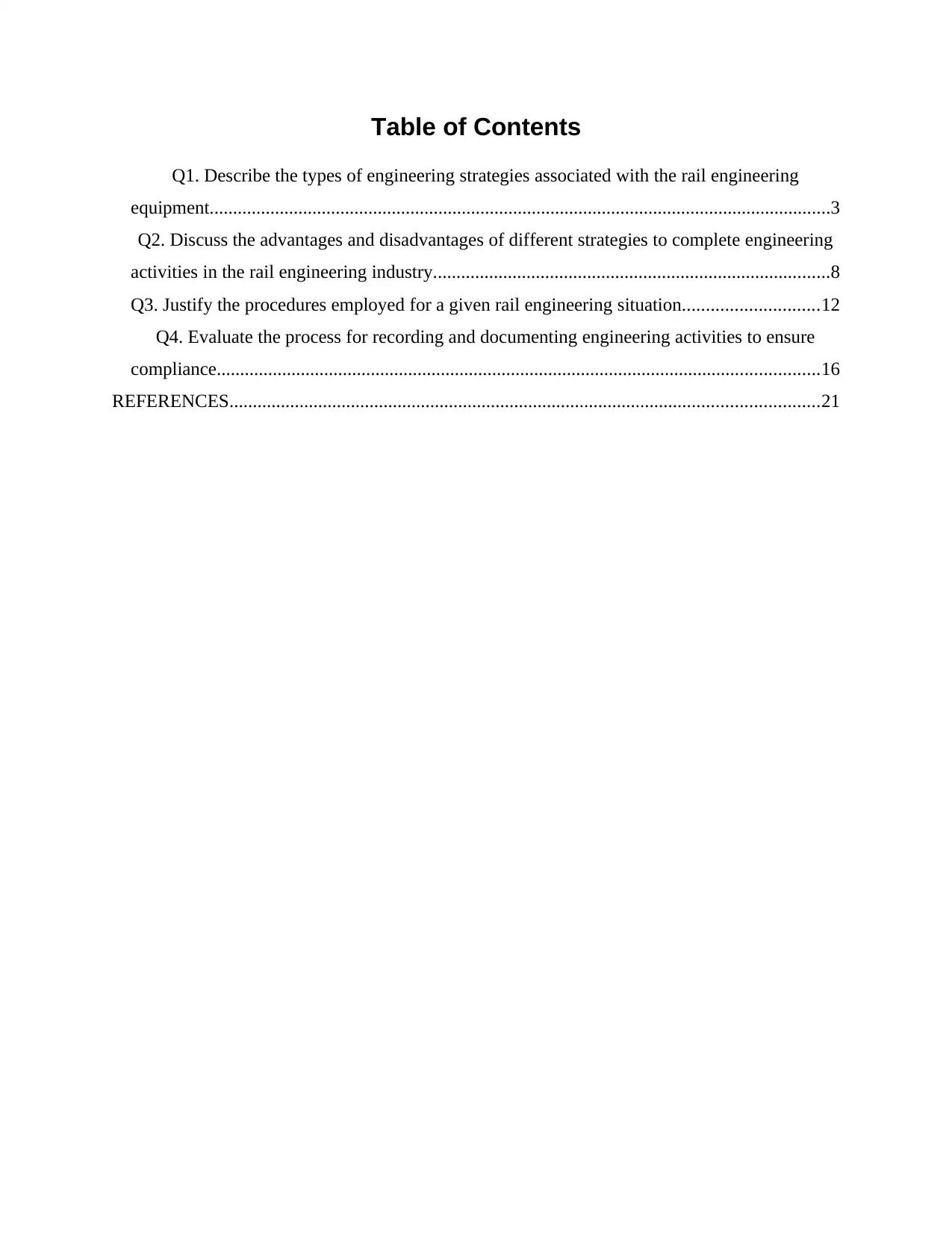
Table of Contents
Q1. Describe the types of engineering strategies associated with the rail engineering
equipment.....................................................................................................................................3
Q2. Discuss the advantages and disadvantages of different strategies to complete engineering
activities in the rail engineering industry.....................................................................................8
Q3. Justify the procedures employed for a given rail engineering situation.............................12
Q4. Evaluate the process for recording and documenting engineering activities to ensure
compliance.................................................................................................................................16
REFERENCES..............................................................................................................................21
Q1. Describe the types of engineering strategies associated with the rail engineering
equipment.....................................................................................................................................3
Q2. Discuss the advantages and disadvantages of different strategies to complete engineering
activities in the rail engineering industry.....................................................................................8
Q3. Justify the procedures employed for a given rail engineering situation.............................12
Q4. Evaluate the process for recording and documenting engineering activities to ensure
compliance.................................................................................................................................16
REFERENCES..............................................................................................................................21
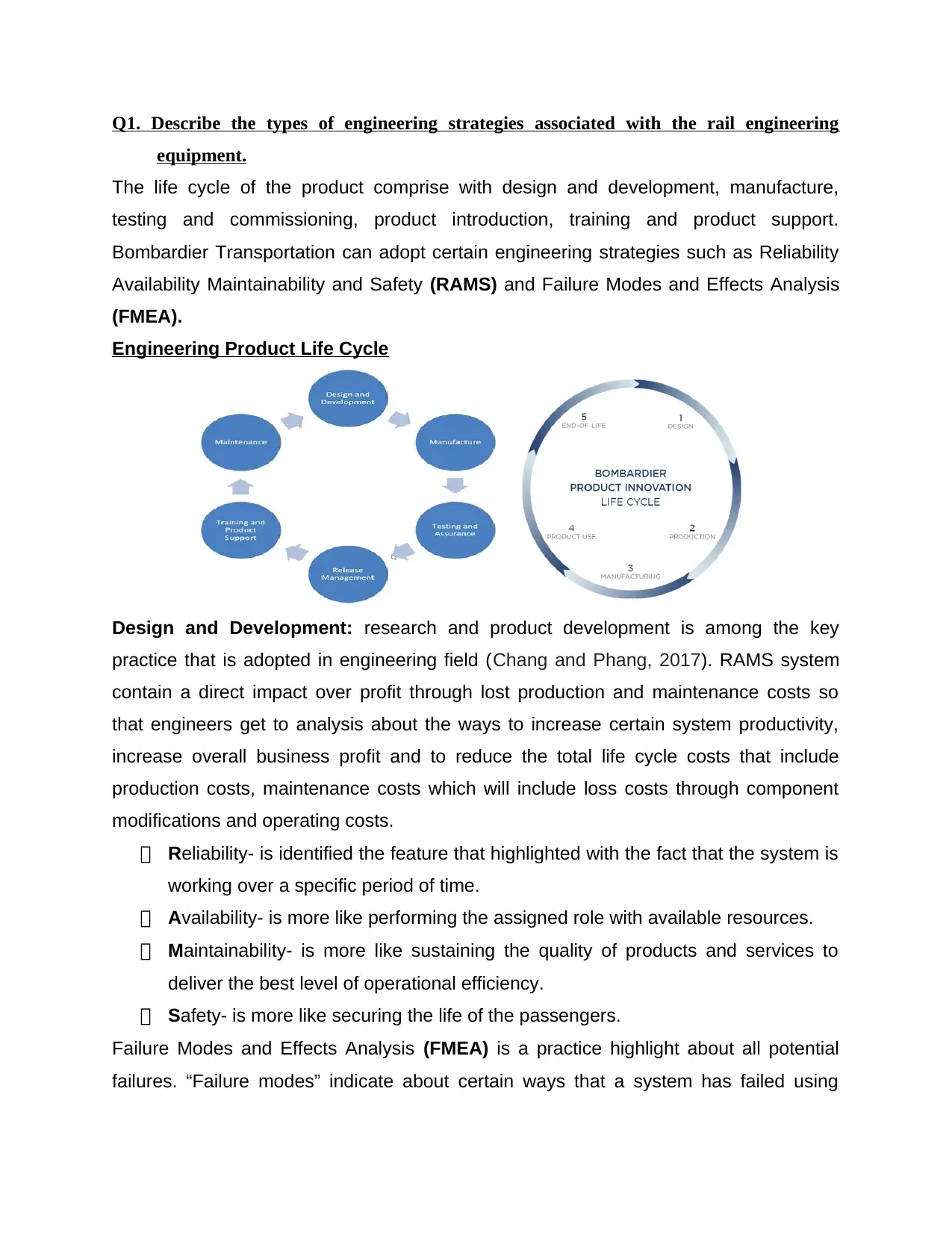
Q1. Describe the types of engineering strategies associated with the rail engineering
equipment.
The life cycle of the product comprise with design and development, manufacture,
testing and commissioning, product introduction, training and product support.
Bombardier Transportation can adopt certain engineering strategies such as Reliability
Availability Maintainability and Safety (RAMS) and Failure Modes and Effects Analysis
(FMEA).
Engineering Product Life Cycle
Design and Development: research and product development is among the key
practice that is adopted in engineering field (Chang and Phang, 2017). RAMS system
contain a direct impact over profit through lost production and maintenance costs so
that engineers get to analysis about the ways to increase certain system productivity,
increase overall business profit and to reduce the total life cycle costs that include
production costs, maintenance costs which will include loss costs through component
modifications and operating costs.
Reliability- is identified the feature that highlighted with the fact that the system is
working over a specific period of time.
Availability- is more like performing the assigned role with available resources.
Maintainability- is more like sustaining the quality of products and services to
deliver the best level of operational efficiency.
Safety- is more like securing the life of the passengers.
Failure Modes and Effects Analysis (FMEA) is a practice highlight about all potential
failures. “Failure modes” indicate about certain ways that a system has failed using
equipment.
The life cycle of the product comprise with design and development, manufacture,
testing and commissioning, product introduction, training and product support.
Bombardier Transportation can adopt certain engineering strategies such as Reliability
Availability Maintainability and Safety (RAMS) and Failure Modes and Effects Analysis
(FMEA).
Engineering Product Life Cycle
Design and Development: research and product development is among the key
practice that is adopted in engineering field (Chang and Phang, 2017). RAMS system
contain a direct impact over profit through lost production and maintenance costs so
that engineers get to analysis about the ways to increase certain system productivity,
increase overall business profit and to reduce the total life cycle costs that include
production costs, maintenance costs which will include loss costs through component
modifications and operating costs.
Reliability- is identified the feature that highlighted with the fact that the system is
working over a specific period of time.
Availability- is more like performing the assigned role with available resources.
Maintainability- is more like sustaining the quality of products and services to
deliver the best level of operational efficiency.
Safety- is more like securing the life of the passengers.
Failure Modes and Effects Analysis (FMEA) is a practice highlight about all potential
failures. “Failure modes” indicate about certain ways that a system has failed using
⊘ This is a preview!⊘
Do you want full access?
Subscribe today to unlock all pages.

Trusted by 1+ million students worldwide
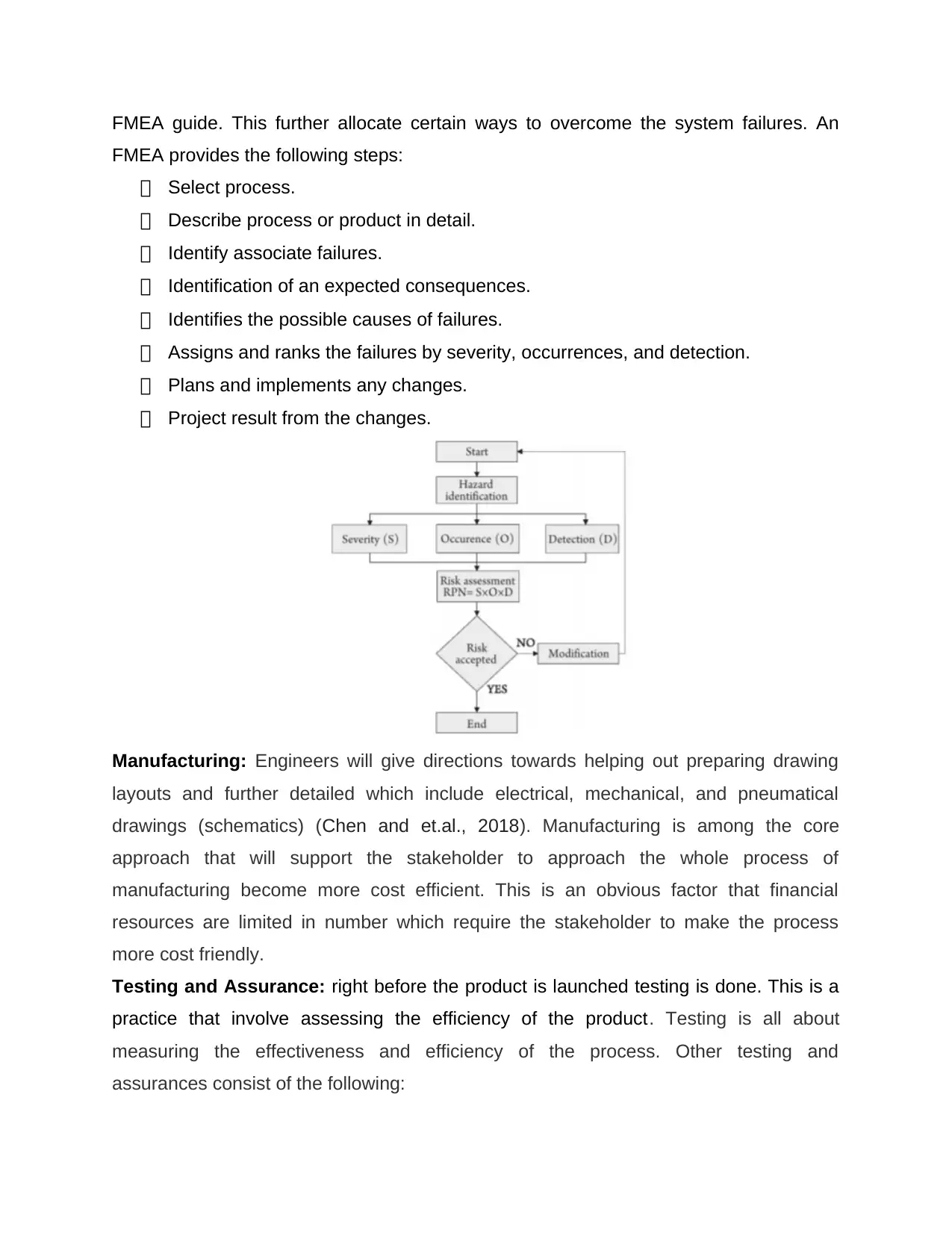
FMEA guide. This further allocate certain ways to overcome the system failures. An
FMEA provides the following steps:
Select process.
Describe process or product in detail.
Identify associate failures.
Identification of an expected consequences.
Identifies the possible causes of failures.
Assigns and ranks the failures by severity, occurrences, and detection.
Plans and implements any changes.
Project result from the changes.
Manufacturing: Engineers will give directions towards helping out preparing drawing
layouts and further detailed which include electrical, mechanical, and pneumatical
drawings (schematics) (Chen and et.al., 2018). Manufacturing is among the core
approach that will support the stakeholder to approach the whole process of
manufacturing become more cost efficient. This is an obvious factor that financial
resources are limited in number which require the stakeholder to make the process
more cost friendly.
Testing and Assurance: right before the product is launched testing is done. This is a
practice that involve assessing the efficiency of the product. Testing is all about
measuring the effectiveness and efficiency of the process. Other testing and
assurances consist of the following:
FMEA provides the following steps:
Select process.
Describe process or product in detail.
Identify associate failures.
Identification of an expected consequences.
Identifies the possible causes of failures.
Assigns and ranks the failures by severity, occurrences, and detection.
Plans and implements any changes.
Project result from the changes.
Manufacturing: Engineers will give directions towards helping out preparing drawing
layouts and further detailed which include electrical, mechanical, and pneumatical
drawings (schematics) (Chen and et.al., 2018). Manufacturing is among the core
approach that will support the stakeholder to approach the whole process of
manufacturing become more cost efficient. This is an obvious factor that financial
resources are limited in number which require the stakeholder to make the process
more cost friendly.
Testing and Assurance: right before the product is launched testing is done. This is a
practice that involve assessing the efficiency of the product. Testing is all about
measuring the effectiveness and efficiency of the process. Other testing and
assurances consist of the following:
Paraphrase This Document
Need a fresh take? Get an instant paraphrase of this document with our AI Paraphraser
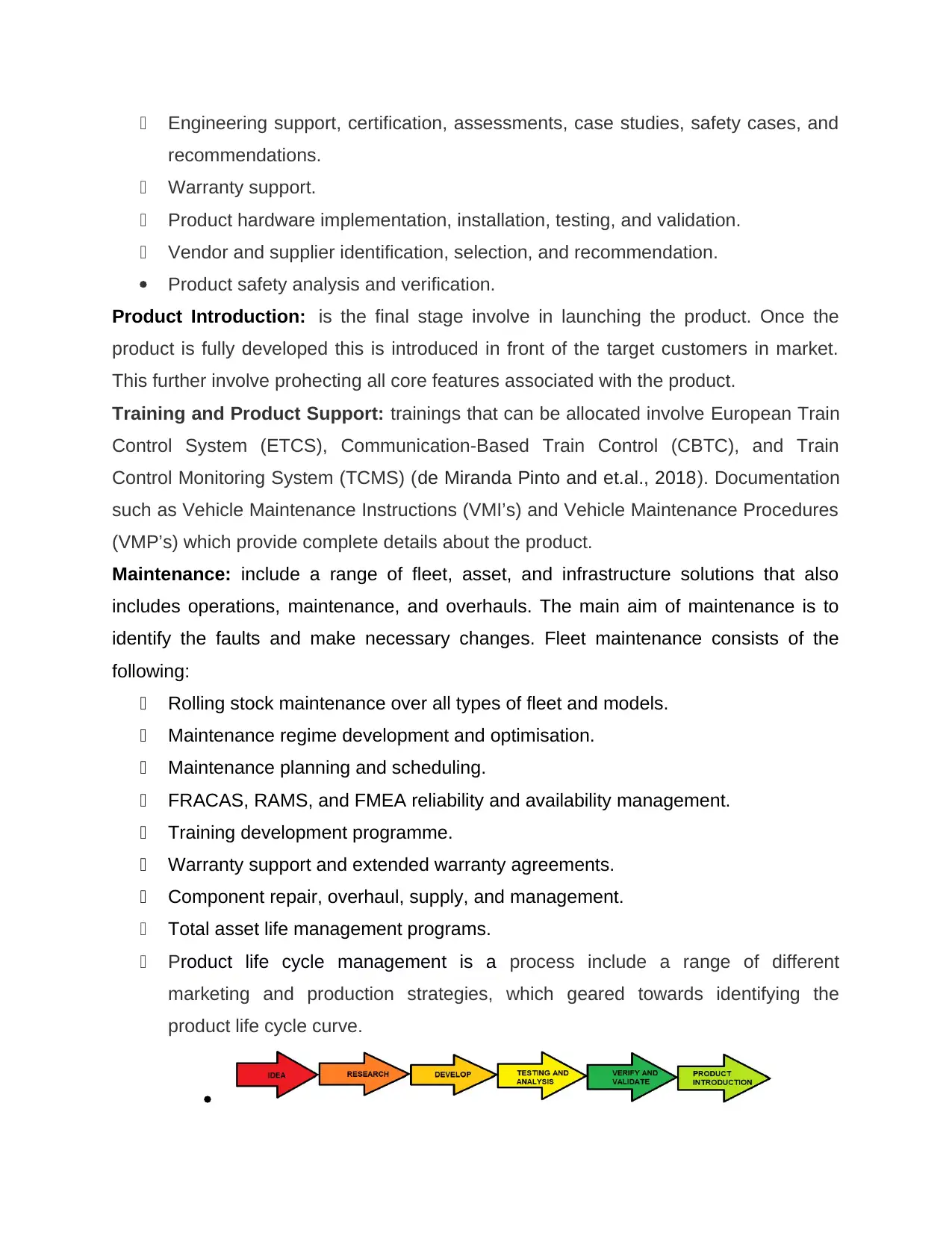
Engineering support, certification, assessments, case studies, safety cases, and
recommendations.
Warranty support.
Product hardware implementation, installation, testing, and validation.
Vendor and supplier identification, selection, and recommendation.
Product safety analysis and verification.
Product Introduction: is the final stage involve in launching the product. Once the
product is fully developed this is introduced in front of the target customers in market.
This further involve prohecting all core features associated with the product.
Training and Product Support: trainings that can be allocated involve European Train
Control System (ETCS), Communication-Based Train Control (CBTC), and Train
Control Monitoring System (TCMS) (de Miranda Pinto and et.al., 2018). Documentation
such as Vehicle Maintenance Instructions (VMI’s) and Vehicle Maintenance Procedures
(VMP’s) which provide complete details about the product.
Maintenance: include a range of fleet, asset, and infrastructure solutions that also
includes operations, maintenance, and overhauls. The main aim of maintenance is to
identify the faults and make necessary changes. Fleet maintenance consists of the
following:
Rolling stock maintenance over all types of fleet and models.
Maintenance regime development and optimisation.
Maintenance planning and scheduling.
FRACAS, RAMS, and FMEA reliability and availability management.
Training development programme.
Warranty support and extended warranty agreements.
Component repair, overhaul, supply, and management.
Total asset life management programs.
Product life cycle management is a process include a range of different
marketing and production strategies, which geared towards identifying the
product life cycle curve.
recommendations.
Warranty support.
Product hardware implementation, installation, testing, and validation.
Vendor and supplier identification, selection, and recommendation.
Product safety analysis and verification.
Product Introduction: is the final stage involve in launching the product. Once the
product is fully developed this is introduced in front of the target customers in market.
This further involve prohecting all core features associated with the product.
Training and Product Support: trainings that can be allocated involve European Train
Control System (ETCS), Communication-Based Train Control (CBTC), and Train
Control Monitoring System (TCMS) (de Miranda Pinto and et.al., 2018). Documentation
such as Vehicle Maintenance Instructions (VMI’s) and Vehicle Maintenance Procedures
(VMP’s) which provide complete details about the product.
Maintenance: include a range of fleet, asset, and infrastructure solutions that also
includes operations, maintenance, and overhauls. The main aim of maintenance is to
identify the faults and make necessary changes. Fleet maintenance consists of the
following:
Rolling stock maintenance over all types of fleet and models.
Maintenance regime development and optimisation.
Maintenance planning and scheduling.
FRACAS, RAMS, and FMEA reliability and availability management.
Training development programme.
Warranty support and extended warranty agreements.
Component repair, overhaul, supply, and management.
Total asset life management programs.
Product life cycle management is a process include a range of different
marketing and production strategies, which geared towards identifying the
product life cycle curve.
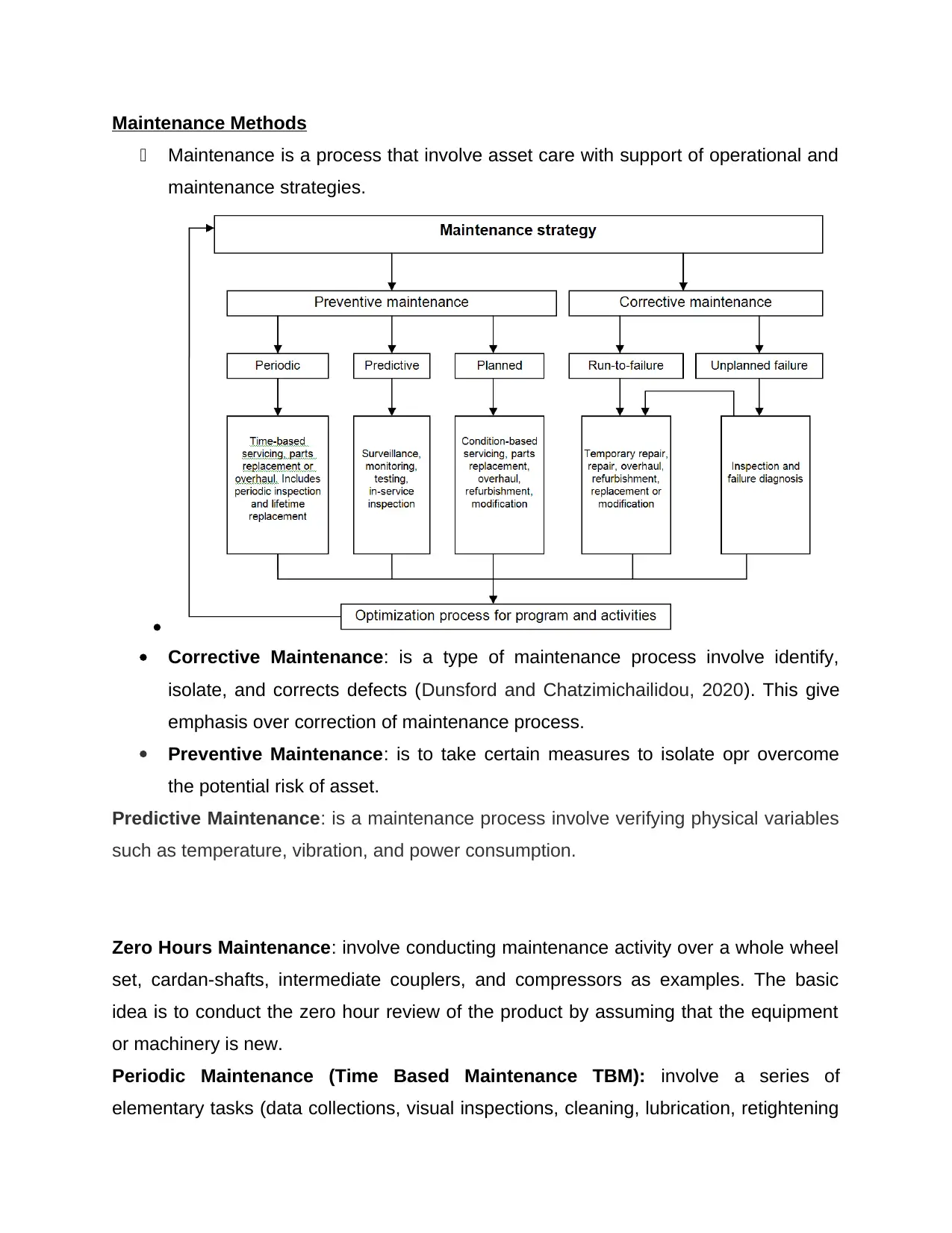
Maintenance Methods
Maintenance is a process that involve asset care with support of operational and
maintenance strategies.
Corrective Maintenance: is a type of maintenance process involve identify,
isolate, and corrects defects (Dunsford and Chatzimichailidou, 2020). This give
emphasis over correction of maintenance process.
Preventive Maintenance: is to take certain measures to isolate opr overcome
the potential risk of asset.
Predictive Maintenance: is a maintenance process involve verifying physical variables
such as temperature, vibration, and power consumption.
Zero Hours Maintenance: involve conducting maintenance activity over a whole wheel
set, cardan-shafts, intermediate couplers, and compressors as examples. The basic
idea is to conduct the zero hour review of the product by assuming that the equipment
or machinery is new.
Periodic Maintenance (Time Based Maintenance TBM): involve a series of
elementary tasks (data collections, visual inspections, cleaning, lubrication, retightening
Maintenance is a process that involve asset care with support of operational and
maintenance strategies.
Corrective Maintenance: is a type of maintenance process involve identify,
isolate, and corrects defects (Dunsford and Chatzimichailidou, 2020). This give
emphasis over correction of maintenance process.
Preventive Maintenance: is to take certain measures to isolate opr overcome
the potential risk of asset.
Predictive Maintenance: is a maintenance process involve verifying physical variables
such as temperature, vibration, and power consumption.
Zero Hours Maintenance: involve conducting maintenance activity over a whole wheel
set, cardan-shafts, intermediate couplers, and compressors as examples. The basic
idea is to conduct the zero hour review of the product by assuming that the equipment
or machinery is new.
Periodic Maintenance (Time Based Maintenance TBM): involve a series of
elementary tasks (data collections, visual inspections, cleaning, lubrication, retightening
⊘ This is a preview!⊘
Do you want full access?
Subscribe today to unlock all pages.

Trusted by 1+ million students worldwide
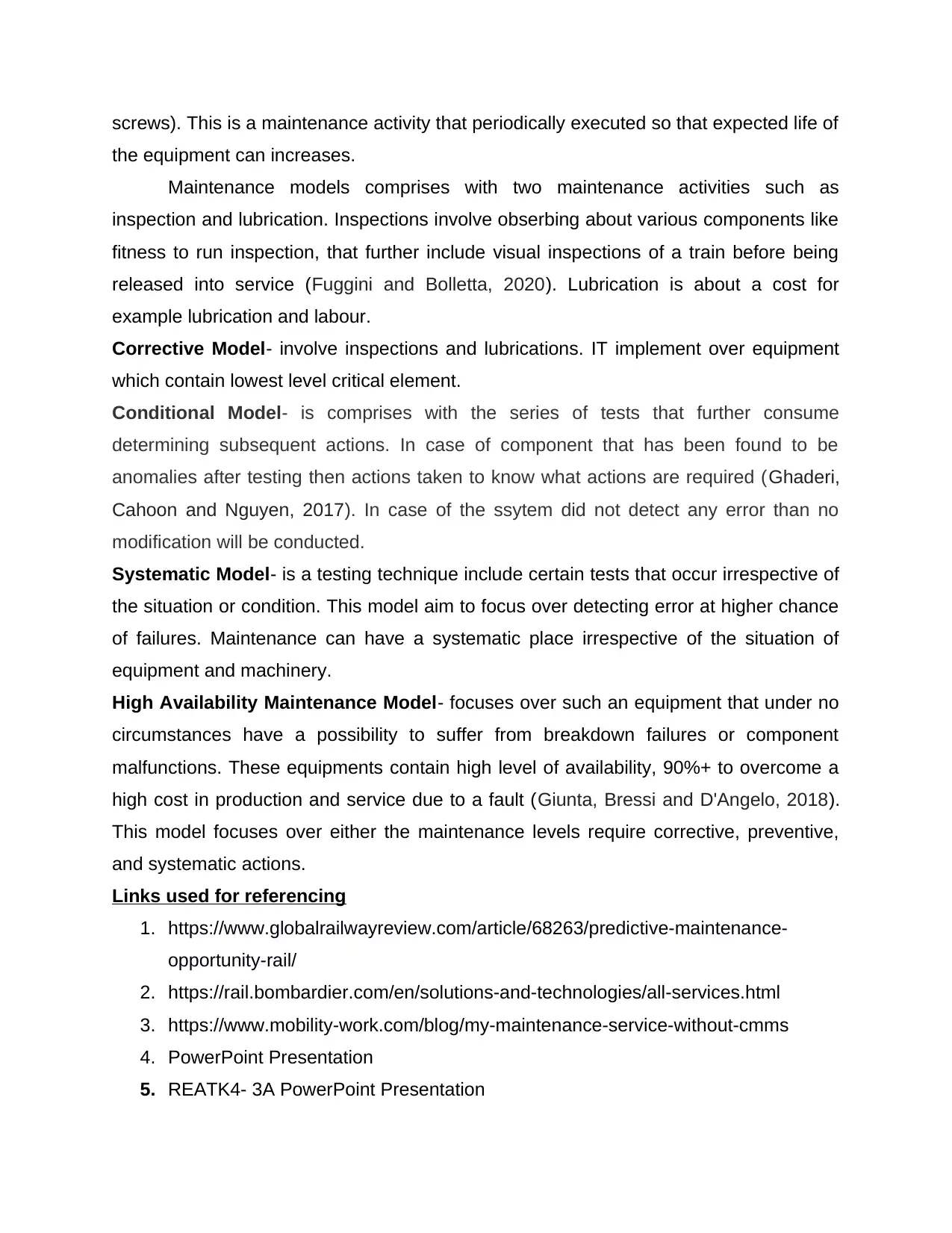
screws). This is a maintenance activity that periodically executed so that expected life of
the equipment can increases.
Maintenance models comprises with two maintenance activities such as
inspection and lubrication. Inspections involve obserbing about various components like
fitness to run inspection, that further include visual inspections of a train before being
released into service (Fuggini and Bolletta, 2020). Lubrication is about a cost for
example lubrication and labour.
Corrective Model- involve inspections and lubrications. IT implement over equipment
which contain lowest level critical element.
Conditional Model- is comprises with the series of tests that further consume
determining subsequent actions. In case of component that has been found to be
anomalies after testing then actions taken to know what actions are required (Ghaderi,
Cahoon and Nguyen, 2017). In case of the ssytem did not detect any error than no
modification will be conducted.
Systematic Model- is a testing technique include certain tests that occur irrespective of
the situation or condition. This model aim to focus over detecting error at higher chance
of failures. Maintenance can have a systematic place irrespective of the situation of
equipment and machinery.
High Availability Maintenance Model- focuses over such an equipment that under no
circumstances have a possibility to suffer from breakdown failures or component
malfunctions. These equipments contain high level of availability, 90%+ to overcome a
high cost in production and service due to a fault (Giunta, Bressi and D'Angelo, 2018).
This model focuses over either the maintenance levels require corrective, preventive,
and systematic actions.
Links used for referencing
1. https://www.globalrailwayreview.com/article/68263/predictive-maintenance-
opportunity-rail/
2. https://rail.bombardier.com/en/solutions-and-technologies/all-services.html
3. https://www.mobility-work.com/blog/my-maintenance-service-without-cmms
4. PowerPoint Presentation
5. REATK4- 3A PowerPoint Presentation
the equipment can increases.
Maintenance models comprises with two maintenance activities such as
inspection and lubrication. Inspections involve obserbing about various components like
fitness to run inspection, that further include visual inspections of a train before being
released into service (Fuggini and Bolletta, 2020). Lubrication is about a cost for
example lubrication and labour.
Corrective Model- involve inspections and lubrications. IT implement over equipment
which contain lowest level critical element.
Conditional Model- is comprises with the series of tests that further consume
determining subsequent actions. In case of component that has been found to be
anomalies after testing then actions taken to know what actions are required (Ghaderi,
Cahoon and Nguyen, 2017). In case of the ssytem did not detect any error than no
modification will be conducted.
Systematic Model- is a testing technique include certain tests that occur irrespective of
the situation or condition. This model aim to focus over detecting error at higher chance
of failures. Maintenance can have a systematic place irrespective of the situation of
equipment and machinery.
High Availability Maintenance Model- focuses over such an equipment that under no
circumstances have a possibility to suffer from breakdown failures or component
malfunctions. These equipments contain high level of availability, 90%+ to overcome a
high cost in production and service due to a fault (Giunta, Bressi and D'Angelo, 2018).
This model focuses over either the maintenance levels require corrective, preventive,
and systematic actions.
Links used for referencing
1. https://www.globalrailwayreview.com/article/68263/predictive-maintenance-
opportunity-rail/
2. https://rail.bombardier.com/en/solutions-and-technologies/all-services.html
3. https://www.mobility-work.com/blog/my-maintenance-service-without-cmms
4. PowerPoint Presentation
5. REATK4- 3A PowerPoint Presentation
Paraphrase This Document
Need a fresh take? Get an instant paraphrase of this document with our AI Paraphraser
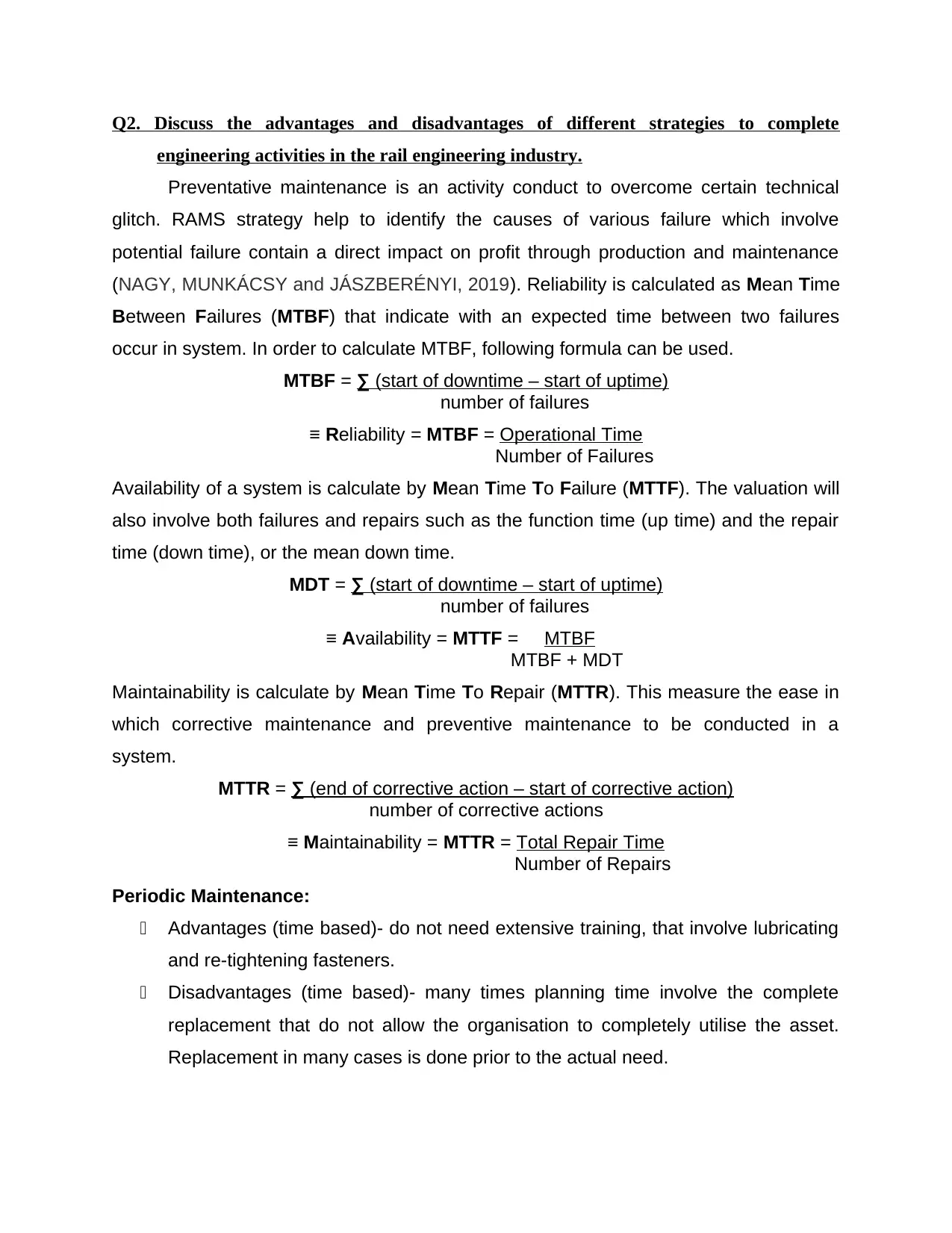
Q2. Discuss the advantages and disadvantages of different strategies to complete
engineering activities in the rail engineering industry.
Preventative maintenance is an activity conduct to overcome certain technical
glitch. RAMS strategy help to identify the causes of various failure which involve
potential failure contain a direct impact on profit through production and maintenance
(NAGY, MUNKÁCSY and JÁSZBERÉNYI, 2019). Reliability is calculated as Mean Time
Between Failures (MTBF) that indicate with an expected time between two failures
occur in system. In order to calculate MTBF, following formula can be used.
MTBF = ∑ (start of downtime – start of uptime)
number of failures
≡ Reliability = MTBF = Operational Time
Number of Failures
Availability of a system is calculate by Mean Time To Failure (MTTF). The valuation will
also involve both failures and repairs such as the function time (up time) and the repair
time (down time), or the mean down time.
MDT = ∑ (start of downtime – start of uptime)
number of failures
≡ Availability = MTTF = 00MTBF000
MTBF + MDT
Maintainability is calculate by Mean Time To Repair (MTTR). This measure the ease in
which corrective maintenance and preventive maintenance to be conducted in a
system.
MTTR = ∑ (end of corrective action – start of corrective action)
number of corrective actions
≡ Maintainability = MTTR = Total Repair Time
Number of Repairs
Periodic Maintenance:
Advantages (time based)- do not need extensive training, that involve lubricating
and re-tightening fasteners.
Disadvantages (time based)- many times planning time involve the complete
replacement that do not allow the organisation to completely utilise the asset.
Replacement in many cases is done prior to the actual need.
engineering activities in the rail engineering industry.
Preventative maintenance is an activity conduct to overcome certain technical
glitch. RAMS strategy help to identify the causes of various failure which involve
potential failure contain a direct impact on profit through production and maintenance
(NAGY, MUNKÁCSY and JÁSZBERÉNYI, 2019). Reliability is calculated as Mean Time
Between Failures (MTBF) that indicate with an expected time between two failures
occur in system. In order to calculate MTBF, following formula can be used.
MTBF = ∑ (start of downtime – start of uptime)
number of failures
≡ Reliability = MTBF = Operational Time
Number of Failures
Availability of a system is calculate by Mean Time To Failure (MTTF). The valuation will
also involve both failures and repairs such as the function time (up time) and the repair
time (down time), or the mean down time.
MDT = ∑ (start of downtime – start of uptime)
number of failures
≡ Availability = MTTF = 00MTBF000
MTBF + MDT
Maintainability is calculate by Mean Time To Repair (MTTR). This measure the ease in
which corrective maintenance and preventive maintenance to be conducted in a
system.
MTTR = ∑ (end of corrective action – start of corrective action)
number of corrective actions
≡ Maintainability = MTTR = Total Repair Time
Number of Repairs
Periodic Maintenance:
Advantages (time based)- do not need extensive training, that involve lubricating
and re-tightening fasteners.
Disadvantages (time based)- many times planning time involve the complete
replacement that do not allow the organisation to completely utilise the asset.
Replacement in many cases is done prior to the actual need.
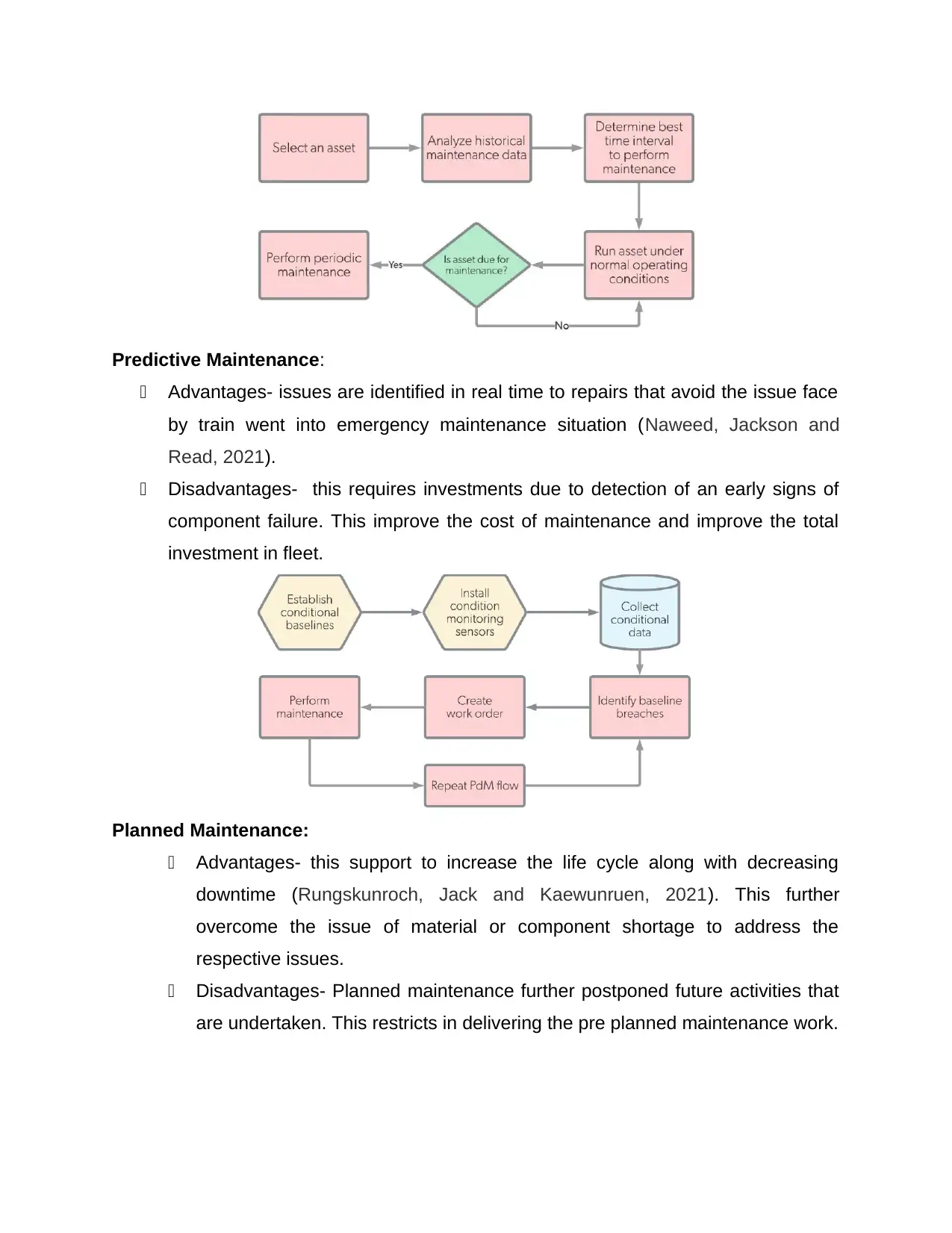
Predictive Maintenance:
Advantages- issues are identified in real time to repairs that avoid the issue face
by train went into emergency maintenance situation (Naweed, Jackson and
Read, 2021).
Disadvantages- this requires investments due to detection of an early signs of
component failure. This improve the cost of maintenance and improve the total
investment in fleet.
Planned Maintenance:
Advantages- this support to increase the life cycle along with decreasing
downtime (Rungskunroch, Jack and Kaewunruen, 2021). This further
overcome the issue of material or component shortage to address the
respective issues.
Disadvantages- Planned maintenance further postponed future activities that
are undertaken. This restricts in delivering the pre planned maintenance work.
Advantages- issues are identified in real time to repairs that avoid the issue face
by train went into emergency maintenance situation (Naweed, Jackson and
Read, 2021).
Disadvantages- this requires investments due to detection of an early signs of
component failure. This improve the cost of maintenance and improve the total
investment in fleet.
Planned Maintenance:
Advantages- this support to increase the life cycle along with decreasing
downtime (Rungskunroch, Jack and Kaewunruen, 2021). This further
overcome the issue of material or component shortage to address the
respective issues.
Disadvantages- Planned maintenance further postponed future activities that
are undertaken. This restricts in delivering the pre planned maintenance work.
⊘ This is a preview!⊘
Do you want full access?
Subscribe today to unlock all pages.

Trusted by 1+ million students worldwide
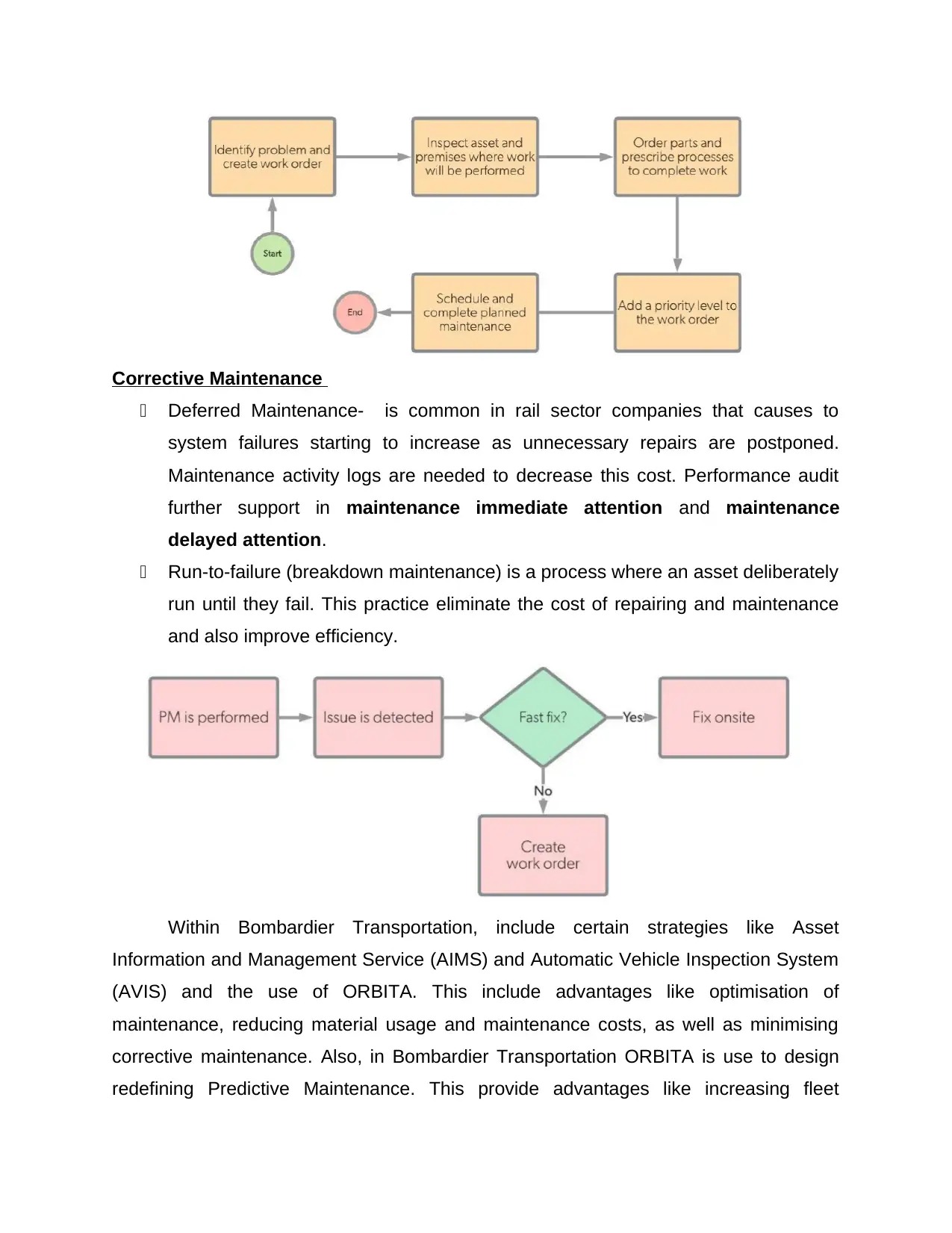
Corrective Maintenance
Deferred Maintenance- is common in rail sector companies that causes to
system failures starting to increase as unnecessary repairs are postponed.
Maintenance activity logs are needed to decrease this cost. Performance audit
further support in maintenance immediate attention and maintenance
delayed attention.
Run-to-failure (breakdown maintenance) is a process where an asset deliberately
run until they fail. This practice eliminate the cost of repairing and maintenance
and also improve efficiency.
Within Bombardier Transportation, include certain strategies like Asset
Information and Management Service (AIMS) and Automatic Vehicle Inspection System
(AVIS) and the use of ORBITA. This include advantages like optimisation of
maintenance, reducing material usage and maintenance costs, as well as minimising
corrective maintenance. Also, in Bombardier Transportation ORBITA is use to design
redefining Predictive Maintenance. This provide advantages like increasing fleet
Deferred Maintenance- is common in rail sector companies that causes to
system failures starting to increase as unnecessary repairs are postponed.
Maintenance activity logs are needed to decrease this cost. Performance audit
further support in maintenance immediate attention and maintenance
delayed attention.
Run-to-failure (breakdown maintenance) is a process where an asset deliberately
run until they fail. This practice eliminate the cost of repairing and maintenance
and also improve efficiency.
Within Bombardier Transportation, include certain strategies like Asset
Information and Management Service (AIMS) and Automatic Vehicle Inspection System
(AVIS) and the use of ORBITA. This include advantages like optimisation of
maintenance, reducing material usage and maintenance costs, as well as minimising
corrective maintenance. Also, in Bombardier Transportation ORBITA is use to design
redefining Predictive Maintenance. This provide advantages like increasing fleet
Paraphrase This Document
Need a fresh take? Get an instant paraphrase of this document with our AI Paraphraser
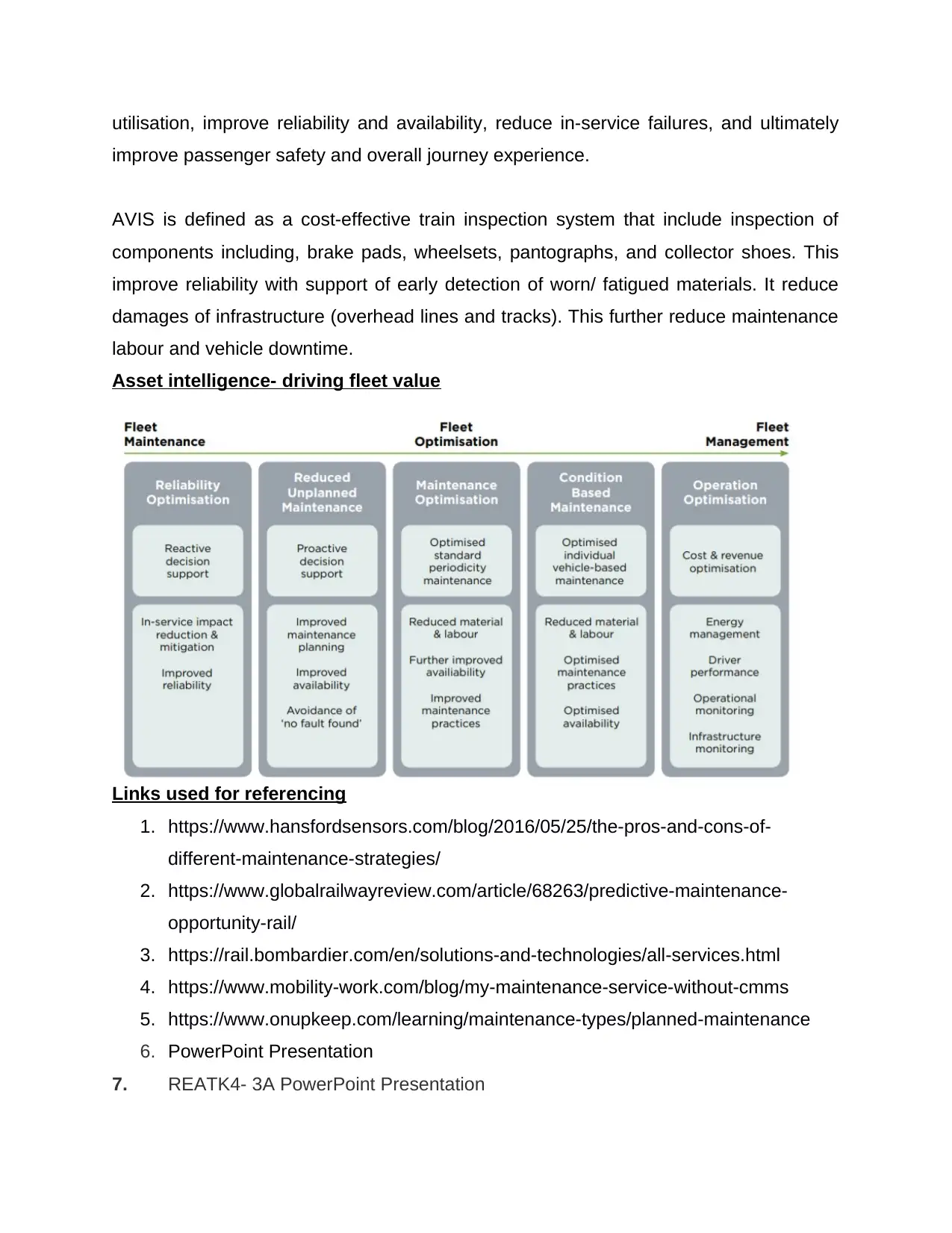
utilisation, improve reliability and availability, reduce in-service failures, and ultimately
improve passenger safety and overall journey experience.
AVIS is defined as a cost-effective train inspection system that include inspection of
components including, brake pads, wheelsets, pantographs, and collector shoes. This
improve reliability with support of early detection of worn/ fatigued materials. It reduce
damages of infrastructure (overhead lines and tracks). This further reduce maintenance
labour and vehicle downtime.
Asset intelligence- driving fleet value
Links used for referencing
1. https://www.hansfordsensors.com/blog/2016/05/25/the-pros-and-cons-of-
different-maintenance-strategies/
2. https://www.globalrailwayreview.com/article/68263/predictive-maintenance-
opportunity-rail/
3. https://rail.bombardier.com/en/solutions-and-technologies/all-services.html
4. https://www.mobility-work.com/blog/my-maintenance-service-without-cmms
5. https://www.onupkeep.com/learning/maintenance-types/planned-maintenance
6. PowerPoint Presentation
7. REATK4- 3A PowerPoint Presentation
improve passenger safety and overall journey experience.
AVIS is defined as a cost-effective train inspection system that include inspection of
components including, brake pads, wheelsets, pantographs, and collector shoes. This
improve reliability with support of early detection of worn/ fatigued materials. It reduce
damages of infrastructure (overhead lines and tracks). This further reduce maintenance
labour and vehicle downtime.
Asset intelligence- driving fleet value
Links used for referencing
1. https://www.hansfordsensors.com/blog/2016/05/25/the-pros-and-cons-of-
different-maintenance-strategies/
2. https://www.globalrailwayreview.com/article/68263/predictive-maintenance-
opportunity-rail/
3. https://rail.bombardier.com/en/solutions-and-technologies/all-services.html
4. https://www.mobility-work.com/blog/my-maintenance-service-without-cmms
5. https://www.onupkeep.com/learning/maintenance-types/planned-maintenance
6. PowerPoint Presentation
7. REATK4- 3A PowerPoint Presentation

Q3. Justify the procedures employed for a given rail engineering situation.
The process involve verification and validation for a given engineering design,
installation, and maintenance needed to employ the engineering change. Engineering
change further need approval from RIS-2700-RST verification. This body give emphasis
over changes like:
Design Conformance
Maintenance Conformance
Construction Conformance
As well as reduced conformance in the form of: -
Minor Modifications
Minor Repairs
Design Replacement Components
Railway approval verification bodies is an authority that give approval over all the
offered changes in the railway. This body look forward to all the required changes that
can support the best level of service and maintenance practices.
Bombardier Transportation focuses on Depot Safety Management System
(DSMS) which involve strategies, plans, processes, and procedures that further give
emphasis on adherence. It look forward to the legal requirements that needed to
endorse in order to implement the identified change (Rusu-Anghel and Ene, 2017). The
DSMS is structured around the Safety Management System (SMS) Logic Tree that
controls risks within a DSMS that is directly engaged with the health and safety
standards of the passengers travel with train. Laws are related to UK Health, Safety and
Environment department responsible for reviewing UK Legislation applicable to all of
Bombardiers sites.
The DSMS logic tree is presented below:
The process involve verification and validation for a given engineering design,
installation, and maintenance needed to employ the engineering change. Engineering
change further need approval from RIS-2700-RST verification. This body give emphasis
over changes like:
Design Conformance
Maintenance Conformance
Construction Conformance
As well as reduced conformance in the form of: -
Minor Modifications
Minor Repairs
Design Replacement Components
Railway approval verification bodies is an authority that give approval over all the
offered changes in the railway. This body look forward to all the required changes that
can support the best level of service and maintenance practices.
Bombardier Transportation focuses on Depot Safety Management System
(DSMS) which involve strategies, plans, processes, and procedures that further give
emphasis on adherence. It look forward to the legal requirements that needed to
endorse in order to implement the identified change (Rusu-Anghel and Ene, 2017). The
DSMS is structured around the Safety Management System (SMS) Logic Tree that
controls risks within a DSMS that is directly engaged with the health and safety
standards of the passengers travel with train. Laws are related to UK Health, Safety and
Environment department responsible for reviewing UK Legislation applicable to all of
Bombardiers sites.
The DSMS logic tree is presented below:
⊘ This is a preview!⊘
Do you want full access?
Subscribe today to unlock all pages.

Trusted by 1+ million students worldwide
1 out of 21
Related Documents
Your All-in-One AI-Powered Toolkit for Academic Success.
+13062052269
info@desklib.com
Available 24*7 on WhatsApp / Email
![[object Object]](/_next/static/media/star-bottom.7253800d.svg)
Unlock your academic potential
Copyright © 2020–2025 A2Z Services. All Rights Reserved. Developed and managed by ZUCOL.





